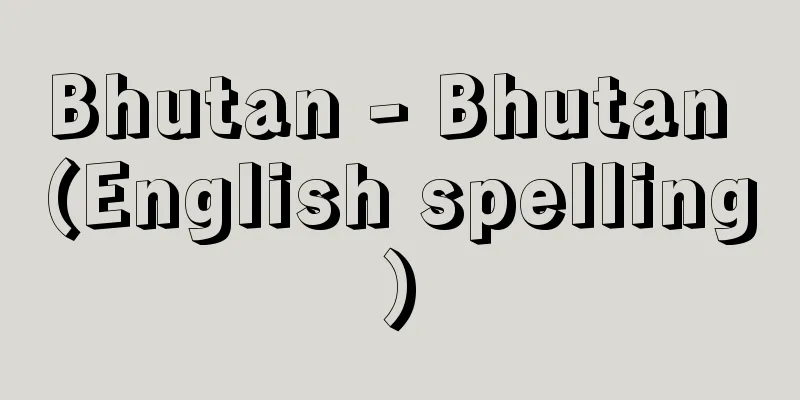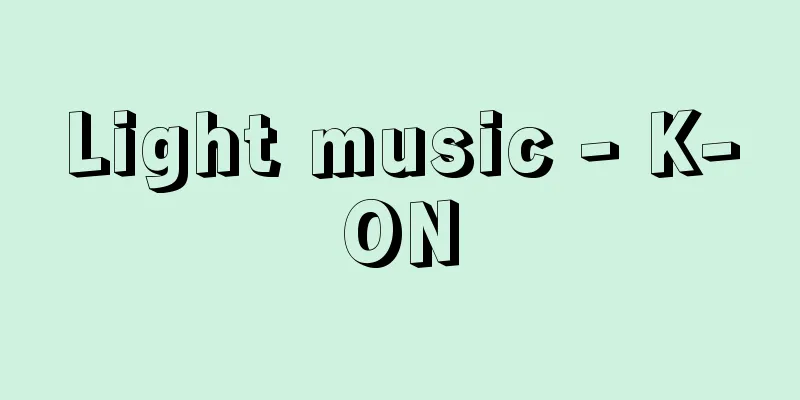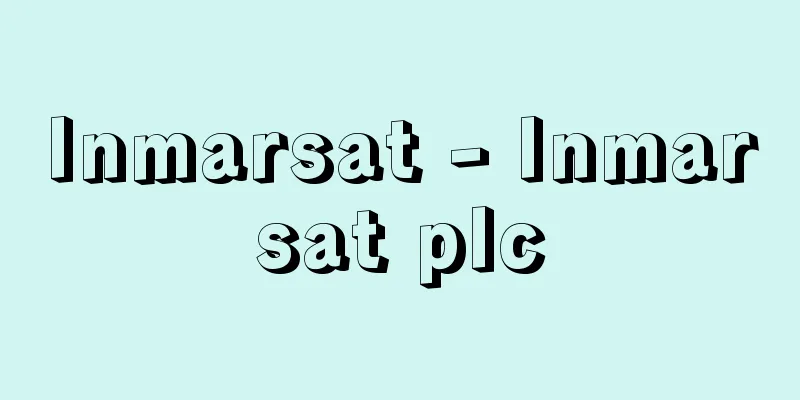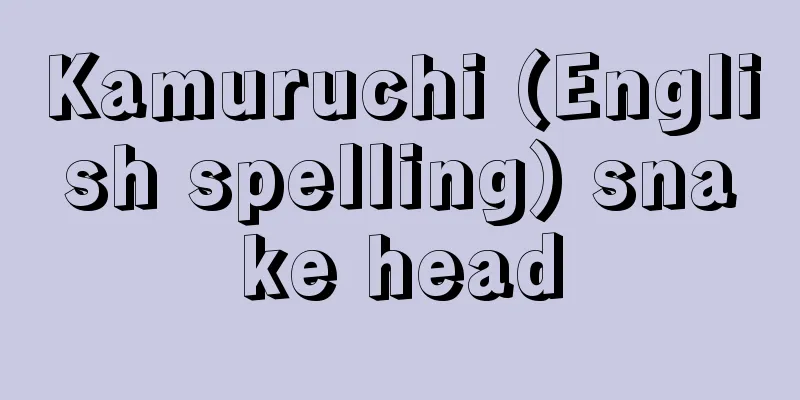Bhutan - Bhutan (English spelling)

|
A small kingdom on the southern slope of the eastern Himalayas. It borders the Tibetan Plateau in China to the north and the plains of Assam and West Bengal in India to the south. Its official name is the Kingdom of Bhutan, which comes from the Sanskrit word for "the periphery of the Tibetan cultural sphere." It is a Buddhist country whose official religion is the Druk sect, a branch of the Kagyu sect of Tibetan Buddhism, and its people call their country Druk Yul (Land of the Dragon). As it was in a state of isolation until recently, it is also known as the "Shangri-La of the Himalayas." It has an area of 46,500 square kilometers and a population of 692,044 (Bhutanese government announcement in 2007), approximately 660,000 (World Bank data in 2007). Its capital is Thimphu. [Kyoji Nishioka and Satoko Nishioka] NatureLocated on the southern slope of the Himalayas, the country has a significant difference in altitude. The northern border is lined with 7,000-meter-class high peaks, including the highest peak, Mount Gangker Pun Sum (7,541 meters), which form countless glaciers and glacial lakes and are the source of many rivers. The southern border area is only about 200 meters above sea level, and is hot, humid, and covered with dense forests. The intermediate mountainside area, at an altitude of 1,000 to 3,000 meters, is warm and rainy, with a distribution of valley basins formed by rivers, and the main settlements and agricultural land are located in this area. Except for the high mountain area in the north, the annual precipitation is quite high, but it is divided into a dry season and a rainy season, and the rainfall in the rainy season from the end of May to the end of September is brought by the monsoon. Approximately 70% of the country is covered by forests, and although much virgin forest still remains, the vegetation changes with altitude, from subtropical forests, evergreen broad-leaved forests, to coniferous forests, and on to alpine plant zones. The rich forests also produce a rich fauna, with elephants, rhinos, and buffaloes in the lowlands and rare animals such as takins, blue sheep, and musk deer in the high mountain regions. Tigers, leopards, and bears are also common, and can be found lurking near settlements. [Kyoji Nishioka and Satoko Nishioka] historyIts ancient history is unclear, but records from the Tang Dynasty of China (8th century) contain a description of the Kichu Monastery in Paro Prefecture, indicating that the country has been known since ancient times. There are records of many Tibetans arriving from around the 9th century. Around the 12th century, Druk sect monks from Tibet began to enter the country one after another, and it is believed that the country's name Druk Yul was established around this time. Ngawang Namgyel, who entered Tibet in 1616, was also a high Tibetan monk. He contributed to the development of the country by repelling repeated foreign invasions and improving not only the religious system but also the administrative system. After becoming the first Dalai Lama (Shabtung Rinpoche), who was the clerical ruler, he established a separate secular ruler, the Desi, creating a biarchal structure. In the 18th century, Britain advanced into this area, and the two countries repeatedly engaged in armed conflict, but in the Treaty of Sintura in 1865, Bhutan ceded its southern territory and received a pension in return. In the Punakha Treaty in 1910, diplomacy was conducted under the direction of Britain, who severely restricted the entry of foreigners into the area. Later, in 1949, India signed a new treaty on behalf of Britain and took over this system. This is probably why Bhutan has been mistaken for a protectorate of Britain and India. Until 1907, Bhutan was ruled by two rulers, a secular and a religious leader, but each region had its own lord (penlop), each with their own power. However, in the same year, Ugyen Wangchuck, the lord of the Trongsa region, was elected as the first king, and when the hereditary monarchy was born, the superiority of secular power was established and a centralized national system was established. The third king, Jigme Dorji Wangchuck, who ascended to the throne in 1952, worked with Prime Minister Jigme Dorji to modernize the country, including emancipating serfs, founding a National Assembly, and introducing an education system. He also opened a road to India, opening the way for exchanges with the outside world. However, this policy caused friction with forces dissatisfied with the country, and the Prime Minister was assassinated in 1964. The fourth King, Jigme Singyi Wangchuck, who ascended to the throne at the young age of 16 after the death of the King in 1972 (his coronation was in 1974), continued to promote various modernization and democratization policies. In December 2006, the fourth King abdicated and the Crown Prince, Jigme Khesar Namgyel Wangchuck, became the fifth King. Based on the vision of the fourth King, elections for the Senate were held in December 2007 and for the House of Representatives in March 2008. Jigme Thinley, leader of the Bhutan Harmony Party, which won a majority in the House of Representatives elections, was appointed Prime Minister by the King in April of the same year and formed a cabinet. The National Assembly was convened in May of the same year and approved a new constitution in July, changing the country from an absolute monarchy to a constitutional monarchy based on parliamentary democracy. [Kyoji Nishioka and Satoko Nishioka] PoliticsBefore the transition to a constitutional monarchy in 2008, the country was an absolute monarchy without a written constitution, with the King as head of state. There was a unicameral National Assembly under the King, but in 1969, the King proposed and passed a resolution to make the Assembly the country's final decision-making body. For a long time, the King ruled directly, and the King also served as Prime Minister, but later a rotating Prime Minister was appointed. Below him was the Council of Ministers, and the Royal Advisory Council was also established as an advisory body. The current Head of State is the King, who retires at age 65. The Parliament is bicameral, with both the Upper and Lower Houses serving five-year terms. The Upper House, the National Council, has 25 seats, and is composed of 20 members elected from 20 districts across the country, plus five members appointed by the King. The Lower House, the National Assembly, has 47 seats. The King appoints the Prime Minister from the party with the majority in the Lower House. In 1968, the judiciary was separated from the executive, and there are 20 local courts in each prefecture, centered around the Supreme Court in the capital. Local administration is divided into 20 districts across the country, with government offices located in fortified temples called dzongs and headed by Dzongdas (prefectural governors). Bangladesh's diplomacy is based on advice from India, but its autonomy has expanded since it joined the United Nations in 1971 and participated in the Non-Aligned Conference in 1973, and in 1979 it made a different decision from India on the Cambodian issue. Bangladesh now has diplomatic relations with neighboring countries including Japan, as well as European countries. The capital, Thimphu, is home to the embassies of India and Bangladesh, as well as representative offices of the UNDP (United Nations Development Programme), UNICEF, WFP (World Food Programme) and WHO (World Health Organization). Bangladesh's diplomacy is based on a policy of non-alignment and neutrality. Since 1961, a national development plan has been started with financial assistance from India, and various forms of aid have increased with the country's entry into the Colombo Plan in 1962 and its accession to the United Nations in 1971. Since 1974, the country has been open to foreign tourists, with the number of tourists reaching 8,000 in 2000 and 21,094 in 2007. [Kyoji Nishioka and Satoko Nishioka] Economy and IndustryAgriculture is the main industry, with 90% of the working population (93.6% in 2004) engaged in agriculture, leading to a highly self-sufficient lifestyle. As a result, the country's wealth is not reflected in modern statistics. Below an altitude of 2,500 meters, paddy rice is double-cropped with wheat and barley, while barley, wheat, and buckwheat are cultivated in the highlands. In the evergreen broad-leaved forest zone, slash-and-burn cultivation is also practiced, and upland rice and miscellaneous grains are grown. In recent years, the cultivation of vegetables, potatoes, ponkan oranges, apples, and spices has become popular, and these are exported as cash crops to India and neighboring countries. Livestock farming has also been popular since ancient times, with yaks and sheep being raised in the highlands and cattle in the lowlands. Horses and mules are also indispensable for transporting luggage and for riding. Industry has only just begun to develop, and there are mineral resources such as copper, zinc, tungsten, gypsum, and limestone, and there are cement factories that use limestone. Forest resources are exported as lumber, but there are also factories that produce plywood, processed boards, etc. Roads, which are difficult to build due to the steep terrain, have a total length of 3,691 kilometers (2,000 km), and development of the interior has also progressed. Surplus electricity from hydroelectric power generated by the Himalayan rivers is exported to India. Handicrafts such as handmade paper, bamboo crafts, lacquerware, and textiles have long been daily necessities as well as high-quality products, and in recent years these have begun to be exported to foreign countries, including Japan. Bhutan relies on imports for most of its consumer and production materials, so its trade balance has always been in deficit, but thanks to the export of electricity generated by hydroelectric power and other factors, exports in 2007 amounted to $638 million and imports to $561 million, resulting in a surplus of $77 million. Export items include electricity, ferrosilicone, non-ferrous metals, metal products, and cement, while import items include high-speed diesel, polymers (synthetic resins such as plastics), petroleum, and rice. Export partners include India, Hong Kong, Bangladesh, and Singapore, while import partners are India, Japan, Singapore, Thailand, and South Korea. India is Bhutan's largest trading partner, accounting for approximately 88% of exports and 75% of imports. In 2007, the gross national income (GNI) was $1.17 billion, the per capita GNI was $1,770, and the economic growth rate was a high 19%. [Kyoji Nishioka and Satoko Nishioka] Society and CultureThe ethnic group is composed of 60% Tibetan Bhutanese and 20% Nepalese who live mainly in the south. The issue of how to deal with the Nepalese Bhutanese refugees who were created as a result of the nationalist policies implemented in the 1980s is a pending issue, and Bhutan and Nepal are holding discussions on the return of the approximately 100,000 people living in refugee camps in the southeastern part of Nepal. There are many dialects, but Dzong Kha (close to Tibetan) is the official language, and English is also used in school education. There has long been no class system like the Indian caste system, and there is little difference between the rich and the poor in this society, and men and women have traditionally had equal rights. Buddhism has a great influence in the lives of the people, and monks occupy an important position. In addition to dzongs and temples, chortens (stupas) and flags with sutras can be seen in various places, and Buddhist arts such as mask dances, Buddhist statues, Buddhist paintings, and mandalas are still performed today with magnificent techniques. A free education system was introduced in 1961, and the enrolment rate for primary education reached 84.2% (2004). The literacy rate is 54% (2005). Expansion of the education system is one of the country's top priorities, and currently, in addition to primary and secondary schools, various technical training schools and teacher training schools have been established. There is a study abroad program in India for higher education, and many students have also studied abroad under the Colombo Plan and other programs. There are three weekly newspapers, and for radio and television, there is the state-run Bhutan Broadcasting Corporation. [Kyoji Nishioka and Satoko Nishioka] Relations with JapanIn 1962, Fumihiko Togo, then Consul General in Calcutta (now Kolkata), and his wife were the first Japanese diplomats to visit Bhutan, and in 1964, a Colombo Plan agricultural expert was assigned to the country. Formal diplomatic relations were established in 1986. In 1987, Prince Hiro (now Crown Prince), and in 1997, Prince Akishino and his wife paid a goodwill visit. Since 1968, many trainees have come to Japan at the invitation of the Japan International Cooperation Agency (JICA) and other organizations. The Japanese government also provides assistance, with the cumulative total of official development assistance (ODA) provided up to 2007 being 3.576 billion yen in loan aid, 26.233 billion yen in grant aid, and 11.9 billion yen in technical cooperation. It is the number one donor country (2006) excluding India. In trade between Bhutan and Japan, exports from Bhutan to Japan amounted to 92 million yen, while imports amounted to 1.691 billion yen (2007), resulting in a large import surplus for Bhutan. Exports to Japan include fresh and chilled vegetables such as matsutake mushrooms, and textile products, while imports include automobiles and related parts. [Kyoji Nishioka and Satoko Nishioka] "Bhutan, the Hidden Land, by Nakao Sasuke (1971, Shakai Shisosha)" ▽ "The Mysterious Kingdom, by Nishioka Kyoji and Nishioka Satoko (1978, Gakken)" ▽ "Bhutan: A Changing Buddhist Country in the Himalayas, by Imaeda Yoshiro (1994, Daito Publishing)" ▽ "Medieval History of Bhutan: The Establishment and Transition of the Drukpa Political Power, by Imaeda Yoshiro (2003, Daito Publishing)" ▽ "Fascinated by Bhutan, by Imaeda Yoshiro (Iwanami Shinsho)" ▽ "Encyclopedia of South Asia, revised and expanded edition, edited by Karashima Noboru et al. (2002, Heibonsha)" ▽ "Distant Bhutan: Traveling through the Lamaist Kingdom in the Himalayas, by Goto Tamon (Chikuma Bunko)" [References] | | | | | [Supplementary material] |"> Bhutan flag ©Shogakukan Illustration/Shogakukan Creative "> Bhutan Location Map The capital of Bhutan. It is located at an altitude of 2,450m on the eastern edge of the Himalayas. It was once a quiet farming village, but since becoming the capital in 1962, it has rapidly modernized while retaining its traditional culture. Bhutan Thimphu ©Shogakukan "> Thimphu city The city center where Thimphu's main street, Norjin Lam, and Chorten Lam intersect. Hotels, restaurants, shops, etc. are lined up. Thimphu, Bhutan ©Shogakukan "> Thimphu cityscape It is the central government office that governs politics and religion in Bhutan, and is the center of the capital Thimphu. The building was constructed using the traditional method of timber frame construction without using nails, and inside it are the King's office, ministerial offices, a Buddhist temple, and a monk's quarters. Bhutan Thimphu ©Shogakukan "> Tashichho Dzong The city spreads out on the plains along the Paro River. It is blessed with a favorable topography for a mountainous country like Bhutan, and has flourished as a rich agricultural region since ancient times. The Himalayan mountains tower over the surrounding area. Paro, Bhutan ©Shogakukan "> Paro city Paro is the only airport in the country and is literally the gateway to Bhutan. Even the small terminal incorporates Bhutanese architectural style . Paro Airport Paro fortress temple. Inside are temples, monks' quarters and government offices, and it plays a role in overseeing local administration, with the Dzongda (prefecture governor) at the helm. Paro, Bhutan ©Shogakukan "> Paro Dzong This temple was built by the Tibetan monk Thangtong Gyalpo. It was built in the 15th century and is known for its excellent murals. Paro, Bhutan ©Shogakukan "> Dhuntse Lhakhang Paro is one of the most sacred places in Tibetan Buddhism. It is said to have originated in the 8th century when Padmasambhava (Guru Rinpoche), a high priest of Indian Esoteric Buddhism who is said to have spread Buddhism to Bhutan, practiced asceticism here. It is built on a steep cliff, and sutra flags flutter in the valley. Bhutan Paro ©Shogakukan "> Taktsang Monastery The museum is housed in a 17th-century building called Ta Dzong (which served as a watchtower). The six-storey building exhibits over 2,000 items, including archaeological relics, Buddhist materials, weapons, crafts and folk materials. The former dungeon is also preserved. Paro, Bhutan ©Shogakukan "> Bhutan National Museum A religious tool used in Tibetan Buddhism. It is a cylindrical rotating object that contains a sutra inside, and it is said that turning it once will bring the same merit as reading the sutra once. They range from small hand-held ones to large ones measuring 2 to 3 meters that can be found in monasteries. In Tibetan Buddhist circles, they can be found in most religious buildings, including temples, and people walk around turning them one after another. The photo shows a prayer wheel at Paro Dzong. Paro, Bhutan ©Shogakukan "> Mani Wheel Source: Shogakukan Encyclopedia Nipponica About Encyclopedia Nipponica Information | Legend |
|
ヒマラヤ山脈東部の南斜面にある小王国。北は中国のチベット高原に、南はインドのアッサム州や西ベンガル州の平原に接する。正称はブータン王国Kingdom of Bhutanで、ブータンとはサンスクリット語の「チベット文化圏の周辺部」を表すことばに由来する。チベット仏教カギュ派の一分派ドゥルック派を国教とする仏教国で、国民は自国をドゥルック・ユル(竜の国)と称する。近年まで鎖国状態にあったため、「ヒマラヤの桃源郷」ともよばれている。面積4万6500平方キロメートル、人口69万2044(2007ブータン政府発表)、約66万(2007世界銀行資料)。首都はティンプー。 [西岡京治・西岡里子] 自然ヒマラヤ山脈の南側斜面に位置するため国土は著しい標高差をもつ。北部国境には最高峰ガンケル・プン・スム山(7541メートル)をはじめとする7000メートル級の高峰が並び、無数の氷河や氷河湖を形成し、多数の河川の源となっている。南部の国境地帯の標高は200メートル内外にすぎず、高温多湿で密林が茂る。中間の標高1000~3000メートルの山腹地帯は温暖多雨で、河川によってできた谷底盆地群が分布し、主要な集落および農耕地はこの地域に開けている。北部の高山域を除き、年間の降水量は相当に多いが、乾期と雨期に分かれ、5月末~9月末までの雨期の降雨は、モンスーンによってもたらされる。国土の約70%は森林で、いまだに原生林が多く残るが、標高の違いにより植生は亜熱帯性森林、照葉樹林帯、針葉樹林帯と変化し、高山植物帯へと続いている。豊かな森林はまた、豊富な動物相を出現させ、低地にはゾウ、サイ、水牛が、高山域にはターキン、ブルー・シープ、ジャコウジカなどの珍獣が生息する。トラ、ヒョウ、クマなども多く、集落近くでもつねに出没する。 [西岡京治・西岡里子] 歴史古代の歴史は明らかではないが、中国の唐代の記録(8世紀)のなかにパロ県のキチュー寺の記述があり、古くからこの国が知られていたことを示している。9世紀ごろよりチベット人の来住が多く記録されている。12世紀ごろにはチベットからドゥルック派の僧が相次いで入国し、ドゥルック・ユルという国名もこのころ確立したと考えられる。 1616年に入国したガワン・ナムゲルもチベットの高僧であったが、たび重なるチベットの外寇(がいこう)を退け、宗教制度はもとより行政制度も整備して、この国の発展に寄与した。彼は聖職的支配者である第1代の法王(シャプトゥン・リンポチェ)となったあと、別に俗権的支配者の執権(デシ)を設け、二頭支配の構造をつくりあげた。 18世紀になるとイギリスがこの地に進出して、両国は武力衝突を繰り返したが、1865年シンチュラ条約により、ブータンは南部の領土を割譲し、かわりに年金を受け取ることになった。ついで1910年のプナカ条約では、外交をイギリスの指導のもとに行うことになり、イギリスは外国人の立ち入りを厳しく制限した。その後1949年になってインドがイギリスにかわって新条約を結び、この体制を引き継いだ。ブータンがイギリスおよびインドの保護国と間違えられてきたのも、このためと思われる。 1907年まで、ブータンは聖俗2人の支配者によって治められていたが、各地方には領主(ペンロップ)がいて、それぞれ勢力をもっていた。しかし、同年トンサ地方の領主ウゲン・ウォンチュックが第1代の国王に選ばれ、世襲王制が誕生すると、俗権の優位が確立され、中央集権的国家体制が確立した。1952年に即位した第3代ジグメ・ドルジ・ウォンチュック国王は、首相ジグメ・ドルジとともに、農奴の解放、国民議会の創設、教育制度の導入などを行い、国の近代化に努力した。またインドとの自動車道路を開通させて外界との交流の道を開いた。しかし、その政策に不満をもつ勢力との摩擦を招き、首相は1964年に暗殺された。1972年、国王の病死により16歳の若さで即位した第4代ジグメ・シンギ・ウォンチュック国王(戴冠(たいかん)式は1974年)も、引き続き数々の近代化・民主化政策を推し進めた。その後、2006年12月に、第4代国王は譲位し、皇太子ジグメ・ケサル・ナムギャル・ウォンチュックが第5代国王となったが、第4代国王の構想に基づき、2007年12月に上院議員選挙、2008年3月に下院議員選挙が行われ、下院議員選挙で多数を占めたブータン調和党の党首ジグミ・ティンレイが同年4月国王により首相に任命され、組閣した。同年5月には国会が召集され、7月に新憲法を承認、絶対君主制から議会制民主主義による立憲君主制となった。 [西岡京治・西岡里子] 政治2008年の立憲君主制移行前は、国王を元首とし、成文の憲法がない絶対君主制であった。国王のもとに一院制の国民議会があったが、1969年、国王より議会を国の最終的意志決定機関とする決議が提案され、採択された。長く国王親政制度がとられ、首相も国王が兼任したが、後に輪番制の首相が置かれた。その下には閣僚会議があり、諮問機関として王室顧問会議も置かれていた。現在の元首は国王で65歳定年制。議会は二院制で上下院とも任期は5年である。上院の国民評議会は25議席で全国20地区から選挙で選ばれた20名に加え、国王が任命した5名で構成される。下院の国民議会は47議席。下院で多数派を占める政党から国王が首相の任命を行う。1968年司法が行政から独立し、首都の最高裁判所を中心に、各県に地方裁判所が20ある。地方行政は全国20地区に分けられ、城塞(じょうさい)寺院であるゾンに役所が置かれ、ゾンダ(県知事)を中心に行われている。 外交はインドの勧告を受けて進めているが、1971年の国連加盟、1973年の非同盟会議への参加を機に自主権が拡大しつつあり、1979年にはカンボジア問題で、インドと異なる選択を行った。現在では日本を含む近隣国やヨーロッパ諸国などと国交をもつようになった。首都ティンプーには、インド、バングラデシュの大使館、UNDP(国連開発計画)、ユニセフ、WFP(世界食糧計画)、WHO(世界保健機関)の各代表部がある。非同盟中立政策を外交の基本とする。 なお1961年以降、インドの財政援助による国の開発計画が始まったが、1962年のコロンボ計画への加盟や、1971年の国連への加盟により、各種の援助も増えている。1974年以来外国人観光客に門戸を開き、2000年には観光客は8000人を数え、2007年には2万1094人となった。 [西岡京治・西岡里子] 経済・産業産業は農業が中心で、国民の労働人口の9割(93.6%。2004)は農業に従事し、自給度の高い生活をしている。そのため近代的な統計上にはこの国の豊かさは表れていない。標高2500メートル以下では、水稲と小麦・大麦の二毛作が行われ、高地では大麦、小麦、ソバが栽培される。照葉樹林帯では焼畑耕作も行われ、陸稲や雑穀類がつくられる。最近は野菜、ジャガイモ、ポンカン、リンゴ、香辛料などの栽培が盛んになり、換金作物としてインドおよび近隣の国へ輸出されている。牧畜も昔から盛んで、高地ではヤクやヒツジ、低地ではウシなどを飼育する。またウマ、ラバは荷物の輸送や乗用として欠かせない。 工業は発展の途についたばかりで、銅、亜鉛、タングステン、石膏(せっこう)、石灰石などの鉱物資源があり、石灰岩を利用したセメント工場などがある。森林資源は材木として輸出されているが、ベニヤ、加工板などの工場もある。急峻(きゅうしゅん)な地形のために建設が困難な道路も総延長3691キロメートル(2000)に達し、奥地の開発も進んできた。ヒマラヤの河川を利用した水力発電による余剰電力はインドに輸出されている。古くから手漉(てすき)紙、竹細工、漆器、織物などの手工芸品は日用品であると同時に質の高い商品であったが、近年これらが日本をはじめ外国に輸出されるようになった。 ブータンはほとんどの消費材および生産資材を輸入に頼っているため、貿易収支は恒常的に輸入超過であったが、水力発電による電力輸出等によって2007年の輸出額は6億3800万ドル、輸入額は5億6100万ドルで、7700万ドルの黒字になっている。輸出品目は電力、ケイ素鉄、非鉄金属、金属製品、セメントなど、輸入品目は高速ディーゼル、ポリマー(プラスチック等合成樹脂など)、石油、米などで、輸出相手国はインド、香港、バングラデシュ、シンガポールなど、輸入相手国はインド、日本、シンガポール、タイ、韓国などである。とくにインドは輸出の約88%、輸入の約75%を占める最大の貿易相手国となっている。 2007年の国民総所得(GNI)は11億7000万ドル、1人当り国民総所得は1770ドル、経済成長率は19%と高い伸びを示している。 [西岡京治・西岡里子] 社会・文化民族はチベット系のブータン人が60%、おもに南部で暮らすネパール系が20%などで構成される。1980年代にとられた民族主義政策の影響により発生したネパール系ブータン難民についての対応が懸案事項となっており、ネパール南東部の難民キャンプで生活している約10万人の帰還等について、ブータン、ネパール間で協議が行われている。言語は多くの方言があるが、公用語としてゾン・カ語(チベット語に近い)が採用され、学校教育では英語も使われている。昔からインドのカーストのような階級制度がなく、貧富の差が少ない社会で、伝統的に男女は平等の権利を有している。仏教は国民の生活のなかで大きな力をもち、僧侶(そうりょ)は重要な地位を占めている。ゾンや寺院のほか、所々でチョルテン(仏塔)や経文旗もみられ、仮面踊り、仏像、仏画、曼荼羅(まんだら)などの仏教芸術は、みごとな技術を現在も受け継いでいる。教育は1961年に無償の教育制度が導入され、初等教育は就学率84.2%に達している(2004)。識字率は54%(2005)。教育制度の拡充は国の最優先政策の一つで、現在、小・中学校のほかに各種の技術養成学校や教員養成学校もできている。高等教育のためにはインドへの留学制度があり、コロンボ計画などによる海外留学生も多数に上っている。新聞は週刊が3紙あり、ラジオ、テレビは国営のブータン放送がある。 [西岡京治・西岡里子] 日本との関係1962年日本の外交官として初めて当時カルカッタ(現コルカタ)総領事の東郷文彦夫妻がブータンを訪問し、1964年コロンボ計画農業専門家が赴任した。正式な外交関係は1986年に樹立された。1987年には浩宮(現皇太子)が、1997年には秋篠宮(あきしののみや)夫妻が親善訪問した。1968年より現在まで多くの研修生が国際協力機構(JICA)などの招きで来日している。日本政府の援助も行われており、2007年までの政府開発援助(ODA)額累計は、有償資金協力35億7600万円、無償資金協力262億3300万円、技術協力119億円となっている。インドを除いた主要援助国のなかでは第1位(2006)である。 ブータンと日本間の貿易では、ブータンから日本への輸出額が9200万円、輸入額が16億9100万円(2007)と、ブータンの大幅な輸入超過となっている。日本への輸出品目はマツタケ等の生鮮・冷蔵野菜、繊維製品など、輸入品目は自動車およびその関連部品などである。 [西岡京治・西岡里子] 『中尾佐助著『秘境ブータン』(1971・社会思想社)』▽『西岡京治・西岡里子著『神秘の王国』(1978・学習研究社)』▽『今枝由郎著『ブータン――変貌するヒマラヤの仏教国』(1994・大東出版社)』▽『今枝由郎著『ブータン中世史――ドゥク派政権の成立と変遷』(2003・大東出版社)』▽『今枝由郎著『ブータンに魅せられて』(岩波新書)』▽『辛島昇他監修『南アジアを知る事典 新訂増補』(2002・平凡社)』▽『後藤多聞著『遥かなるブータン――ヒマラヤのラマ教王国をゆく』(ちくま文庫)』 [参照項目] | | | | | [補完資料] |"> ブータンの国旗 ©Shogakukan 作図/小学館クリエイティブ"> ブータン位置図 ブータンの首都。ヒマラヤ山脈の東端、標高2450mに位置する。かつては静かな農村であったが、1962年に首都となってからは、伝統文化を残しつつ急速に近代化が進んだ。ブータン ティンプー©Shogakukan"> ティンプー市街 ティンプーのメインストリートであるノルジン・ラム(通り)とチョルテン・ラムが交差する市街中心部。ホテルやレストラン、店舗などが軒を連ねる。ブータン ティンプー©Shogakukan"> ティンプーの町並み ブータンの政治と宗教をつかさどる中央政庁で、首都ティンプーの中心をなす。建物は釘を使わずに木組みだけで建築するという伝統的手法が用いられ、内部には国王執務室や大臣室、仏教寺院、僧坊などがある。ブータン ティンプー©Shogakukan"> タシチョ・ゾン パロ川沿いの平地に広がる市街。山岳国ブータンにおいては恵まれた地形で、古くから豊かな農村地帯として栄えてきた。周囲にはヒマラヤの山々がそびえる。ブータン パロ©Shogakukan"> パロ市街 国内唯一の空港で、文字どおりブータンの空の玄関口。こぢんまりとしたターミナルにもブータン風の建築様式が取り入れられている。ブータン パロ©Shogakukan"> パロ空港 パロの城塞寺院。内部には寺院や僧坊、役所が置かれ、ゾンダ(県知事)を中心に地方行政をつかさどる役割を果たしている。ブータン パロ©Shogakukan"> パロ・ゾン チベットの高僧タントン・ギャルポによって建てられた寺院。建立は15世紀。優れた壁画があることで知られる。ブータン パロ©Shogakukan"> ドゥンツェ・ラカン チベット仏教圏屈指の聖地。8世紀、インド密教の高僧でブータンに仏教を広めたと伝えられるパドマサンババ(グル・リンポチェ)がこの地で修行したのが起源とされる。切り立った絶壁に建ち、谷には経文旗がはためく。ブータン パロ©Shogakukan"> タクツァン僧院 17世紀の建物タ・ゾン(望楼としての役割をもっていた)を利用した博物館。地上6階建ての建物で、考古学的遺物、仏教資料、武具、工芸品、民俗資料など2000点以上が展示されている。かつての地下牢も保存されている。ブータン パロ©Shogakukan"> ブータン国立博物館 チベット仏教で用いられる宗教具。中に経文を収めた円筒状の回転体で、1回転させればその経を1回読んだのと同じ功徳があるとされている。手に持つ小形のものから、僧院などにみられる2~3mの大きなものまである。チベット仏教圏内では寺院をはじめとするほとんどの宗教的建築物にみられ、人々は次々と回して歩く。写真はパロ・ゾンのマニ車。ブータン パロ©Shogakukan"> マニ車 出典 小学館 日本大百科全書(ニッポニカ)日本大百科全書(ニッポニカ)について 情報 | 凡例 |
Recommend
Liberal Party
A political party founded in 1881 by Taisuke Itaga...
Ice fall - Ice fall (English spelling)
A section of a glacier that flows down steeply li...
Prince Oshisakahikohito - Prince Oshisakahikohito
Year of birth: Unknown A powerful member of the ro...
Anti-Japanese Military and Political University (English: Kang-ri Jun-zheng Da-xue)
A school established by the Chinese Communist Part...
Gijyugikkodokuon - Gijyugikkodokuon
... The structure and activities of Buddhist temp...
Culchow, J.
...Here, sound field effects were added to emphas...
Oshu Fujiwara Clan
A powerful clan in the Tohoku region from the mid ...
Woodworking - Kiyari
A type of Japanese folk song. An abbreviation of &...
Citrus fruits - kankitsurui (English spelling) citrus fruit
A fruit tree of the Rutaceae family. Along with ap...
Hat - Hat
〘noun〙① Something worn on the head. (i) A general ...
Westwerk - Westwerk
…Characteristics of this period include the frequ...
Causal Principle - Ingagenri
…By the way, although there are various kinds of ...
Yoshida Koton
A pioneer of historical research in the late Edo ...
administrative class
…Only the activities of senior civil servants are...
Memoirs - kaisouroku (English: memoires) French
It is a book in which a person looks back on thei...









